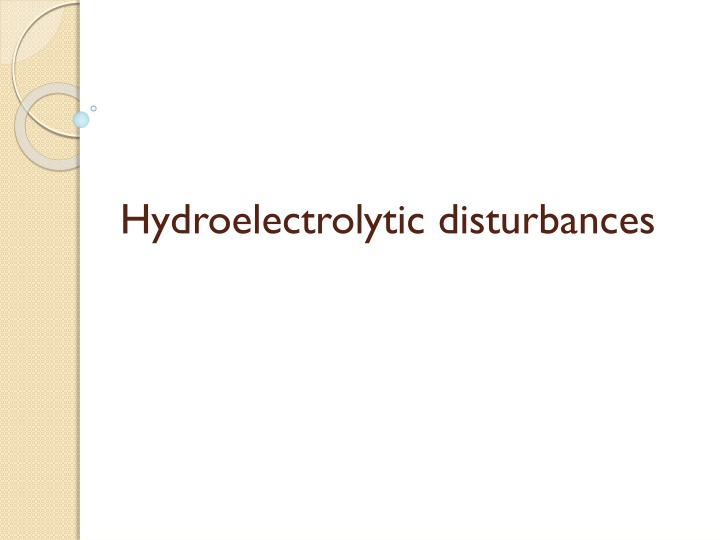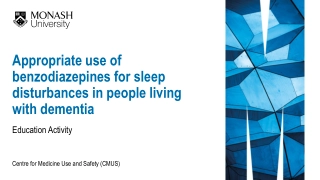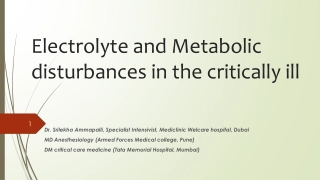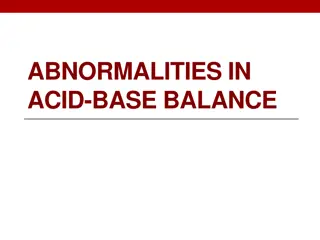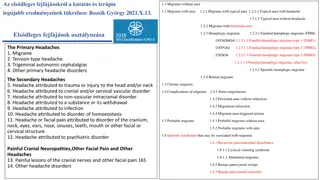Hydroelectrolytic disturbances
Body fluids play a crucial role in maintaining homeostasis through fluid balance, electrolyte balance, osmotic balance, and acid-base balance. Learn about the distribution of body fluids, daily water balance, electrolytes, and lab normals to understand the intricacies of water distribution and electrolyte regulation within the body.
Download Presentation

Please find below an Image/Link to download the presentation.
The content on the website is provided AS IS for your information and personal use only. It may not be sold, licensed, or shared on other websites without obtaining consent from the author.If you encounter any issues during the download, it is possible that the publisher has removed the file from their server.
You are allowed to download the files provided on this website for personal or commercial use, subject to the condition that they are used lawfully. All files are the property of their respective owners.
The content on the website is provided AS IS for your information and personal use only. It may not be sold, licensed, or shared on other websites without obtaining consent from the author.
E N D
Presentation Transcript
Homeostasis Body fluids are in constant motion transporting nutrients, electrolytes, and oxygen to cells while carrying away waste products The maintenance of normal volume and normal composition of the extracellular fluid is vital to life Homeostasis: the various physiologic arrangements which serve to restore the normal state, once it has been disturbed Fluid balance Electrolyte balance Osmotic balance Acid-base balance
Distribution of body fluids total body water 0,6/0,5x(kg body weight) intracellular extracellular -interstitial (lymph) and transcellular (third-space, water distributed in the digestive tract, spinal fluid) -intravascular Intracellular and extracellular water move back and forth through the cell membrane (osmotic change). The intracellular water in adult males averages 57% of the total body water. pleural, peritoneal,
DailyWater Balance (liters) OUTPUT INPUT FLUID INTAKE 1.5 INSENSIBLE 0.8 IN FOOD 0,8 SWEAT 0,1 METABOLIC 0.3 FECES 0.2 Total 2,6 URINE 1.5 Total 2.6
Electrolytes (mEq) Chemicals dissolved in the body fluid Regulated by intake, output, acid-base balance, hormones, and cell integrity Sodium -major extracellular electrolyte -controls and regulate water balance Potassium -major intracellular electrolyte -helps maintain intracellular water balance -transmit nerve impulses to muscles
Ionic fluid area content Ions,meq/L Plasma Extracellular Intracellular Na+ 141 143 15 K+ 4 4 140 Ca+ 2,5 1,3 0,0001 Mg+ 1 0,7 15 Cl- 103 115 8 HCO3- 25 28 15 SO4- 0,5 0,5 10
Lab Normals Magic 4 Electrolyte Range Magic 4 Potassium 3,5-5,5 4 Chloride 98-106 104 Sodium 135-145 140 pH 7,35-7,45 7,4 pCO2 35-45 40 HCO3 22-26 24
Water distribution distribution of water and electrolytes between compartments is dependent on: Osmolarity Tonicity Electroneutrality Starling balance
Osmolarity and osmolality Indicates the water balance of the body Serum osmo is 285-295 mOsm/kg -high is water deficit (concentrated) -low is water excess (dilute) Urine osmo is 50-1200 mOsm/kg Together are used to determine what is causing a sodium imbalance Urine osmo/serum osmo=1/3
Regulation of fluid and electrolyte movement Filtration the fluid passes through the membrane (hydrostatic pressure, oedema) Diffusion is the net movement of molecules from a region of high concentration to a region of low concentration Osmosis is the way water moves between two spaces, solutes create the concentration gradients that promote osmosis (Osmolarity of extracellular space depends on the sodium concentration in plasma and is equivalent to the osmolarity of the intracellular space which is given by the potassium.) Active transport (molecules have to move against to gradient, so they requires some energy and pump, Na/K/ATP)
Ionic balance provide: the resting membrane potential, generated by intracellular and extracellular ion concentrations ratio neuromuscular excitability
Regulation of water balance Kidneys (JG cells) Kidneys (adrenal cortex) Hypothalamus Heart Senses low serum osmo or low Na Releases aldosterone Reabsorbs Na into the blood, increases K excretion in the urine Increases serum osmo Senses high serum osmo or high Na Stimulates thirst Triggers release of ADH (vasopresine) from posterior pituitary Retains water in the blood Concentrates urine Mildly constricts blood vessels Decreases serum osmo Senses high volume through stretch receptors in the right atrium SecretsANP,BNP Inhibits ADH Increases Na excretion through the urine Dilates blood vessels Decreases serum osmo Sense low Na, low volume Release renin Converts angiotensinogen to angiotensin I which converts to angiotensin II Stimulates release of aldosterone
Fluid disorders Are represented by: Volume and Osmolarity disorders we refer primarily to extracellular space Water lack or excess Sodium lack or excess Intracellular space is determined by the volume and osmolarity of extracellular space.
Fluid disorders The mechanisms involved in the pathology development of fluid and electrolyte are: ingestion disorders eliminate disorders disorders of control mechanisms
Primary disorders Water deficiency Water excess Sodium excess Sodium deficiency
Disturbances of fluid homeostasis Diagnosis: Physical signs: skin turgor, oedema, mucous membranes, neck veins, puls, liver, level of consciousness, capillary refill, fontanel (children) Clinical sings: blood pressure; heart rate; (respiratory rate); body temperature; CVP; urine output; serum and urine Na, osmolarity; Htk; serum total protein
Fluid volume deficit (no water, no salt, or both) No water (hypertonic) -profuse sweating, hyperventilation, fevers, diarrhea, renal failure, DI No salt (hypotonic) -water intoxication, chronic illness, malnutrition, renal failure Both (isotonic) -NPO, poor intake, hemorrhage
Dehydration Isotonic Hypertonic Hypotonic Se Na Se osmolarity Hb Htk Blood volume Thirst n n + + - + + + + - - - + + - mod. increase increased no
Fluid volume deficit Low BP, tachycardia Dry moth, thirst Rapid weight loss Low urine output Confusion, lethargy elevated Htk, decreased CVP What are the symptoms? Fluids (oral if alert) NS or LR (no potassium until urine output is increased) What can you do? Daily weight May need antidiarrheals, antiemetics, antipyretics
Fluid volume excess Increased sodium and water Causes: -hypervolemia (isotonic) Too much IV fluid, kidney failure, corticosteroids -water intoxication (hypotonic) SIADH, IV fluids, psych problems, wound irrigation -too much sodium intake (hypertonic) Too much salt, 3%saline IV, too much NaHCO3
Fluid volume excess Rapid weight gain Edema High BP, bounding pulses May have increased urine output Neck vein distention, crackles, dyspnea Low Htc, low blood urea, high Na, low osmo What are the symptoms? Diuretics Fluid restriction (no IV fluids) Sodium restriction What can you do? Daily weights
Sodium Major cation of ECF Regulated by kidneys, ADH, aldosterone GI tract absorbs sodium from food Imbalances are typically associated with fluid volume problems Foods high in sodium processed meats, condiments, dairy
Hypernatremia Water loss or excess sodium Decreased Na excretion renal failure, corticosteroids Increased Na intake eating too much salt, too much sodium in IV fluids Increased water loss fever, infection, sweating, diarrhea over nasogastric feeding, hyperosmolar coma, dehydration secondary to fever or ambient temperature increase diabetes insipidus excessive administration of hypertonic solution and Sodium bicarbonate You are fried Fever (low grade, flushed skin) R Restless (irritable) I Increased fluid retention and BP E Edema (peripheral) D Decreased urine output, dry mouth F
Hypernatremia What can you do? Reduce sodium slowly! Treat the underlying cause Diuretics Sodium restriction Seizure precautions
Hyponatremia Water excess or loss of sodium Dilution polydipsia, freshwater drowning, SIADH Increased excretion sweating, diuretics, GI wound drainage, renal disease Decreased intake NPO, law salt diet, severe vomiting/diarrhea Symptoms: -confusion, headaches -seizures (can progress to coma) -abd. cramps
Hyponatremia Replace sodium slowly! What can you do? 3%normal saline If caused by fluid excess, will need fluid restriction Usually can not be fixed by adding sodium to the diet
Sodium deficiency-hyponatremia Hyponatremia with euvolaemia is Syndrome of inappropriate antidiuretic hormone secretion (SIADH) The diagnostic criteria are: - hyponatremia with hypo-osmolarity - permanent removal of sodium (elimination is proportional to ingestion.) - urinary hyperosmolarity compared with plasma - absence of other causes to decrease the dilution capacity of the kidney - absence of hyponatraemia and hypo osmolarity after restriction of water
Potassium Major cation of Intracellular Fluid, helps maintain Intracellular Fluid volume Key role in the resting membrane potential and action potential of neurons and muscle fibers the inter-compartment gradient is maintained by the activity of Na/K/ATP-ase, that pumps Sodium out of cells while pumping Potassium into cells, both against their concentration gradients K+level is controlled by aldosterone (increased Na and decreased K by reabsorbtion or not in kidney). Primary route of loss kidney
Hyperkalemia Causes Impaired excretion Renal failure Use of salt or potassium supplements Receiving old blood Hypoxia Exercise (catabolic state) Drugs (potassium sparing diuretics) Shifts of K out of cells Tissue breakdown (Cell destruction) acidosis, insulin deficiency
Hyperkalemia MURDER M muscle weakness U urine, oliguria, anuria R respiratory distress D decreased cardiac contractility E ECG changes R reflexes, hyperreflexia, or areflexia
Hyperkalemia Therapy: Cardiac monitor Kayexalate Movement of extracellular K into intracellular compartment Insulin (+glucose) Sodium bicarbonate Calcium gluconate Removal K from the body Diuretics Dialysis if severe -stop potassium in IV fluids -avoid foods high in potassium
Hypokalemia Causes: Decreased K intake Increased excretion: vomiting, diarrhea, renal losses, diuretics Shifts of K into cells: drugs (Insulin, 2-adrenergic agonists, Theophylline, Caffeine), alkalosis
Hypokalemia Signs and symptoms: ECG changes paralytic ileus lack of muscle tone and muscle strength, rhabdomyolysis Coma Metabolic alkalosis
Hypokalemia What can you do? Cardiac monitor Foods high in potassium Watch for Digoxin toxicity Potassium IV (only if good urine output) Spironolactone Treat constipation Potassium administration Must have urine output Never give IV push Must be on cardiac monitor Assess IV site (prefer CVC) Always dilute and give no more than 20 mEq, no faster than 1 hr Max concentration in IV fluids is 40 mEq/l
